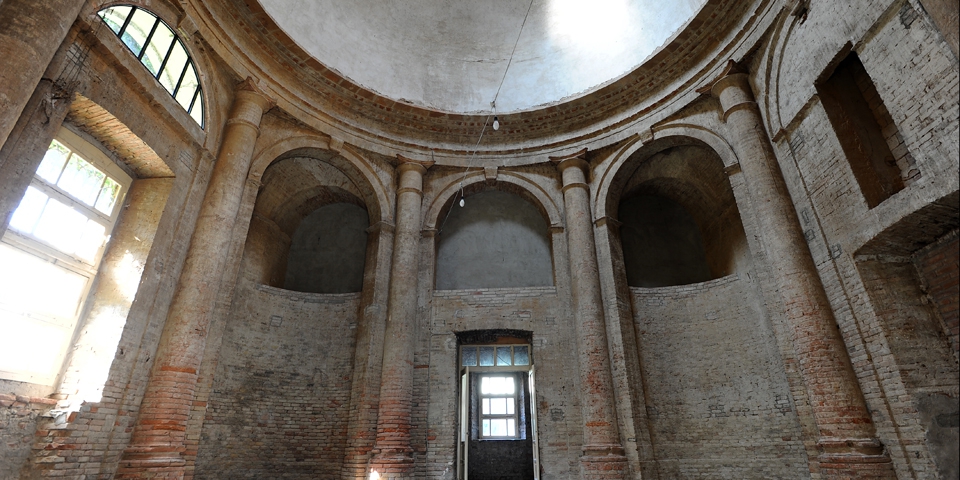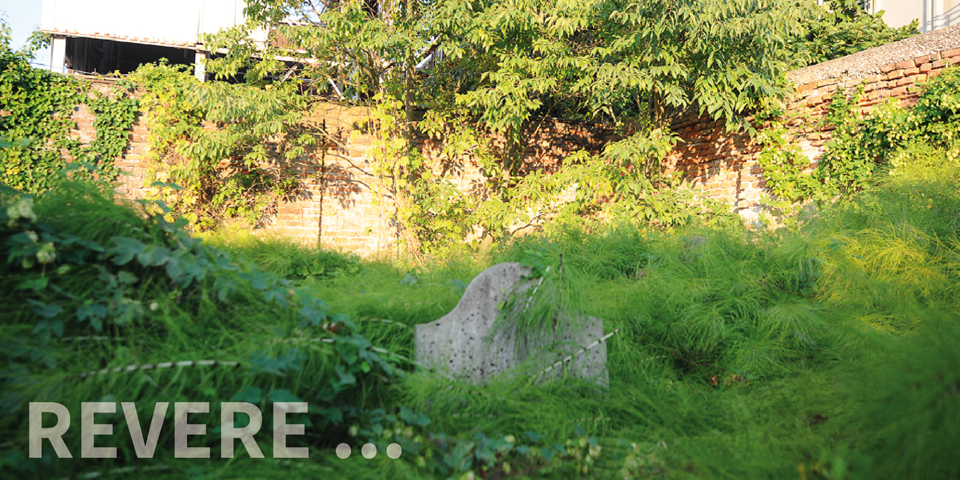SOUTH-EAST ITINERARY

A circular itinerary to cover by car through Revere, Viadana, Pomponesco, Casalmaggiore, Rivarolo Mantovano, and Bozzolo. Ideal for a weekend, stopping over night in one of these small but fascinating places.

IN REVERE THE OLD CEMETERY IN THE COURTYARD OF A GLASS FACTORY
Revere is 35 km from Mantua, and it’s a walled city on the banks of the river Po. Since 1332, it is part of the duchy of the Gonzaga family of Mantua.It is the first and one of the most important Jewish settlements of the forty-eight ones in the Mantua area, in a strategic location. In 1630 a thousand Mantuan Jews embarked from Revere to escape the Lanzichenecchi and the plague. Crammed on rafts to reach the Duchy of Mirandola, attacked by bandits, they were shipwrecked and they died en masse. The old synagogue in the fortified part of the castle was repeatedly damaged by the soldiers quartered in the town. It was abandoned when the group diminished and became very poor. There is a small cemetery in the present-day via Cavour 8, outside the built-up area towards Ferrara. It is incorporated in a glass blowing factory, now closed, and it is hard-to-reach. Do not miss Palazzo Ducale, an extraordinary example of Mantuan Renaissance (1450-1460). In piazza Castello there is an isolated tower, the last ruin of the medieval castle. The parish of the Blessed Virgin Mary, dedicated to the Annunciation, with a brick façade and frescoes, partially closed for damage from the 2012 earthquake. On the banks of the river Po the floating mill had been rebuilt, and it was operative until 1900. Factual note: Revere has become a Jewish surname.
IN VIADANA THE GREAT UNFINISHED SYNAGOGUE
Proloco - via Verdi 6 - tel.0375 780090. Viadana is located 45 km from Mantua, not far from the banks of the Po. Feud of the Cavalcabò and then under the Gonzaga, in 1443 it welcomed moneylender Jews of Germanic origin. They lived around the Gonzaga’s armoury castle, now destroyed. They grew in number over time, concentrating behind Piazza Manzoni, in via Bonomi and in vicolo San Filippo, now known as the former ghetto. The first synagogue was on the top floor of Via Bonomi 29, operating from 1532 to the end of the nineteenth century. It was an oblong room, with the high frieze of the wall frescoed with a sacrificial procession of cherubs. Five stripping off frescoes, recently painted, are in the Parazzi Civic Museum. A second great synagogue, designed by Carlo Visioli, in the same via Bonomi 28-34, has remained unfinished. Perhaps it immediately became apparent, it was too big for the small local community. It is a large room on the ground floor, with a monumental dome, columns, and signs of women’s galleries ever made on the mezzanine level. Now private property and partially restored, it can be visited on request, and it has been used for thirty years as a carpenter’s shop. The cemetery (the second one) is in via Paraluppa. A plaque with Hebrew inscriptions is on display at the Civic Museum, which is located just opposite the area of the former Ghetto.
POMPONESCO, BELOVED AND DESCRIBED BY THE WRITER ALBERTO CANTONI
In the fifteenth century, Pomponesco was the country house of the Marquis (later Count) Giulio Cesare Gonzaga, and developed into the new built-up area around the castle, surrounded by walls with four corner towers and one in the entrance. The project remained unfinished when Giulio Cesare Gonzaga became prince of Bozzolo, moving his interests there. Pomponesco remained an agricultural centre, closed by the bank of the river Po on the southern side of the central piazza 23 Aprile. In this square the town hall and the Church of Santa Felicita face each other. The buildings in the square and in the adjacent little square had been built between 1590 and 1630. At that time, in 1558, the brothers Leone, Angelo, and Lazzaro di Cologna and also Joseph di Cologna opened a loan bank. The area was important for the river trade, in particular of grain. The countryside, however, were at risk of the rivers overflowing. In 1607 the Cantoni family arrived, that took part in the agricultural development of the area, then becoming an important landowners. Alberto Cantoni (1841-1904), writer and enlightened intellectual, left in his will part of his possessions to the poor of Pomponesco. Via Fratelli Cantoni is dedicated to him and to his sister Giulia, and the Jewish cemetery (maintained by the Municipality) is at the bottom of it. On the same street, at number 15, the synagogue abandoned after the last war should have been. A bust of Alberto Cantoni is located under the arcade of the Town Hall. 6 km from the town there is the regional nature reserve, the Garzaia of Pomponesco, which is very important for flora and fauna.
CASALMAGGIORE, CITY OF ART WITH A LIVELY JEWISH PRINTING WORKS
Proloco - Piazza Garibaldi 6 - tel. 0375 40039 - casalmaggioreturismo.it. Casalmaggiore is 40 km from Cremona, on an embankment of the left bank of the river Po. Town rich in artistic treasures on the spectacular Piazza Garibaldi with the neo-Gothic Town Hall, the neoclassical Duomo, the sixteenth-century Church of Santa Chiara and the neoclassical Palazzo Mina. Jewish typographers, among which the Soncino, worked in the town along with a large group of moneylenders: ten family units of 71 people, expelled in 1597. Today there remain important typographical works.
IN RIVAROLO MANTOVANO THERE IS GARIBALDI IN THE SYNAGOGUE
Rivarolo Mantovano is 35 km from Mantua, at the right of the lower course of the river Oglio. It is a charming Renaissance town ( www.comune.rivarolo.mn.it/ not to be missed) with three centuries of Jewish presence. In 1522 The Gonzaga allowed the brothers Joseph, Solomon and Lazzaro, the sons of Moses Levi from Rivarolo, to open a bank. The group grew over the time with the arrival of merchants and scholars. Afterwards, under the Austrian dominion, for the first time Jews were occupied in agriculture and industry. The Finzi family introduced a new silk processing method. They opened a manufactory in Bozzolo and a factory of raw silk in Rivarolo. Throughout the area twenty-four plants of mulberry trees for the silkworm breeding were planted. Giuseppe Finzi, one of the Martyrs of Belfiore, was a member of the family. The group lived in the sixteenth-century building on the Piazza Giuseppe Finzi. There is a one and only yard and also passages between the houses to get to the synagogue. It is a very large room, lit by five windows, overlooked by a dome-skylight. In 1903 it was sold to the Society of Mutual Aid among workers of Rivarolo and it became a meeting room. The chairman was Giuseppe Finzi, and from 1864 Giuseppe Garibaldi was the honorary president. The thank you message written by Caprera is on the wall in the Aron with the portrait of the hero at the top. There are two cemeteries: the older one at Porta Brescia (within the walls) and a second one by Porta Mantova (outside the walls). In the hall of the Municipal Library there is a plaque of Mosé Finzi, while others are in front of the entrance of the Christian cemetery.
WELCOME AND PEACEFUL COEXISTENCE FOR THE JEWS IN BOZZOLO
Located 28 km from Mantova, Bozzolo is a small, precious village enclosed by walls, and was designed in 1532 by Vespasiano Gonzaga and then by his grandchildren Giulio Cesare and Scipione. It welcomed the Jews Isaac, Angelo Cantoni, Aoria di Ventura and his brothers, moneylenders in touch with the myriad of little banks scattered in the Mantuan countryside. The group suddenly grew in 1630 with the arrival of six hundred fugitives from the Lanzichenecchi after the sacking of Mantua. A synagogue, belonging to the Cantoni family, was in the present via Bonoldi 10, in the old town centre. The building was deeply transformed in the nineteen fifties, and is now a house. A small cemetery (the second one) outside the walls is perfectly restored, and is located in via Cremona, immediately on the right after the level crossing, coming from the centre. It has 26 tombstones, three of which are eighteenth century. Not to be missed, the central Piazza Europa with the City Hall, the neoclassical theatre and, not far, the churches of San Francesco (with Giulio Cesare Gonzaga's tomb) and of the Santissima Trinità. In via Matteotti is the sixteenth-century palace of the former court. In the parish church of San Pietro, The Duomo of Bozzolo, there is the tomb of Don Primo Mazzolari (1890-1959) by Giacomo Manzù. Inside the Duomo is a great organ, of considerable value.
















